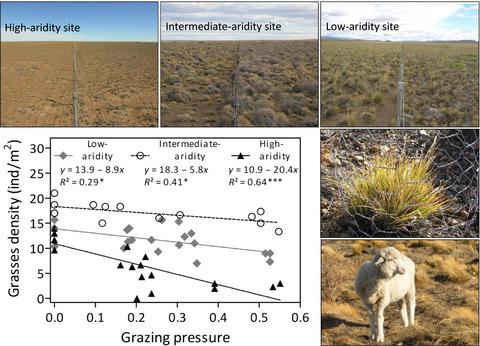当前位置:
X-MOL 学术
›
J. Appl. Ecol.
›
论文详情
Our official English website, www.x-mol.net, welcomes your
feedback! (Note: you will need to create a separate account there.)
Aridity exacerbates grazing‐induced rangeland degradation: A population approach for dominant grasses
Journal of Applied Ecology ( IF 5.0 ) Pub Date : 2020-06-23 , DOI: 10.1111/1365-2664.13704 Gastón R. Oñatibia 1, 2 , Gerónimo Amengual 2 , Luciano Boyero 1, 2 , Martín R. Aguiar 1, 2
中文翻译:

干旱加剧放牧草地的退化:优势草的种群方法
更新日期:2020-06-23
Journal of Applied Ecology ( IF 5.0 ) Pub Date : 2020-06-23 , DOI: 10.1111/1365-2664.13704 Gastón R. Oñatibia 1, 2 , Gerónimo Amengual 2 , Luciano Boyero 1, 2 , Martín R. Aguiar 1, 2
Affiliation

|
- The current human‐induced intensification of grazing pressure and the aridity increase as a result of climate change are unprecedented and have been identified as the main drivers that cause desertification in rangelands world‐wide. In these ecosystems, human well‐being mostly depends on plant species that provide forage for domestic herbivores. However, scarce evidence exists about the interaction between regional aridity level and human‐induced disturbances as determinants of forage plant populations' structure and dynamics.
- We studied the effects of domestic grazing intensification on the population structure of dominant native grasses, in three rangeland sites located across a regional aridity gradient: a semi‐desert (high‐aridity site), a shrub–grass steppe (intermediate‐aridity site) and a grass steppe (low‐aridity site). We also studied the effect of 2‐year grazing exclusion on the growth of defoliated plants of a key native forage grass species common to the three sites.
- Grazing decreased total grass density and increased the frequency of small plants in all sites, particularly for forage species. However, the size of the grazing intensification effect was the greatest in the high‐aridity site, where intensive grazing produced a ten‐fold reduction of grass density. Moreover, defoliated plants recovery (growth) was lower as aridity increased.
- Synthesis and applications. Our study provides evidence of a negative synergistic effect of grazing pressure and aridity that may lead to the collapse of grass populations. Long‐term grazing intensification degrades the population structure of grasses, particularly in high‐aridity sites, where the forage provision is substantially reduced. These results refute the hypothesis that plant traits of dominant species adapted to high aridity allow them to resist herbivory. Besides, high aridity delays plant recovery after defoliation (low resilience). The management of both grazing pressure and the length of grazing rest according to ecological‐site aridity are key aspects for maintaining the forage provision of rangelands. Monitoring plant populations' structure through time and space strengthens inferences about responses of forage species to ongoing changes in disturbance and stress regimes. This knowledge is complementary to regional and world‐wide monitoring endeavours based on land cover, and it contributes to the robust design of sustainable management of global rangelands.
中文翻译:

干旱加剧放牧草地的退化:优势草的种群方法
- 当前人为引起的放牧压力的加剧和气候变化导致的干旱增加是前所未有的,并且已被确定为导致全世界牧场荒漠化的主要驱动力。在这些生态系统中,人类的福祉主要取决于为家庭食草动物提供草料的植物物种。然而,关于草食植物种群结构和动态的决定因素,区域干旱水平与人为干扰之间相互作用的证据很少。
- 我们研究了分布在区域干旱梯度上的三个牧场地上的放牧集约化对优势原生草种群结构的影响:半沙漠(高干旱地带),灌木-草干草原(中度干旱地带)和草草原(低干旱地区)。我们还研究了2年放牧对三个地方常见的主要原生牧草种类的落叶植物生长的影响。
- 放牧降低了所有地点的总草密度,并增加了小植株的发生频率,特别是对于牧草种类。但是,在高干旱地区,放牧集约效应的规模最大,那里的密集放牧使草密度降低了十倍。此外,随着干旱的增加,落叶植物的恢复(生长)降低。
- 综合与应用。我们的研究提供了放牧压力和干旱的负面协同效应的证据,这可能导致草种群崩溃。长期放牧集约化会降低草的种群结构,特别是在草料供应大大减少的高干旱地区。这些结果驳斥了这样的假设,即适应高干旱的优势种的植物性状可以抵抗草食性。此外,高干旱会延缓落叶后植物的恢复(低复原力)。根据生态场所的干旱程度来管理放牧压力和放牧休息时间是保持牧场草料供应的关键方面。监测植物种群 穿越时空的结构加强了对饲草物种对扰动和压力状态持续变化的反应的推论。这些知识是对基于土地覆盖的区域和全球监测工作的补充,并且有助于对全球牧场的可持续管理进行稳健的设计。











































 京公网安备 11010802027423号
京公网安备 11010802027423号